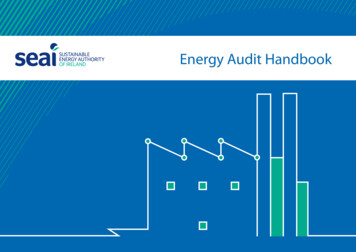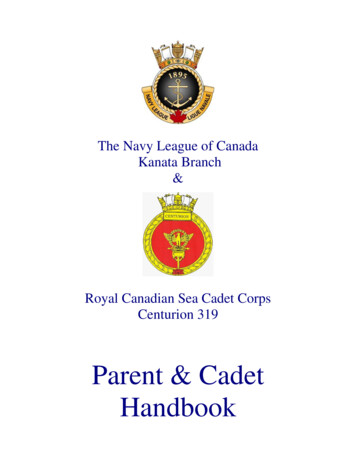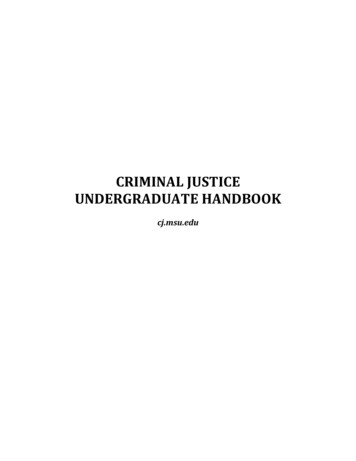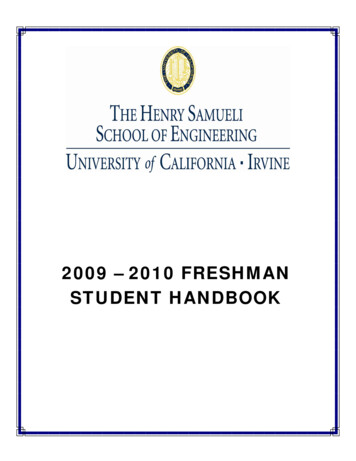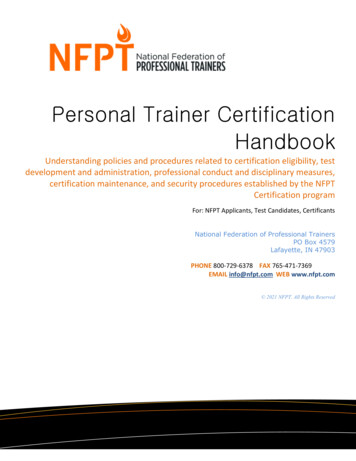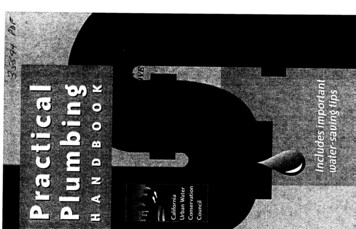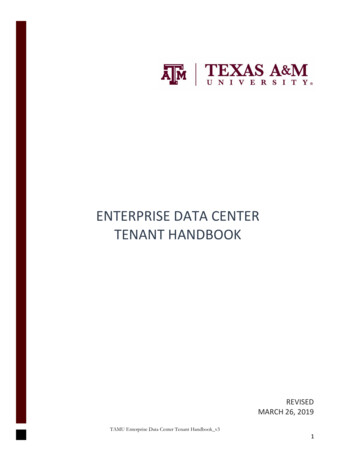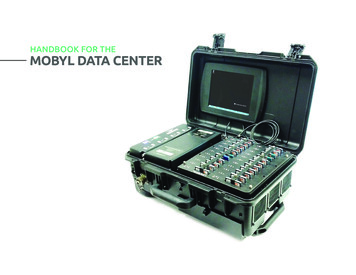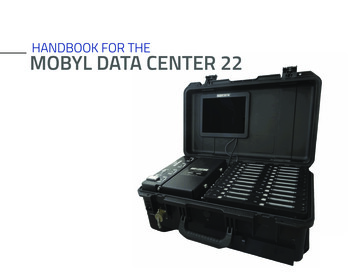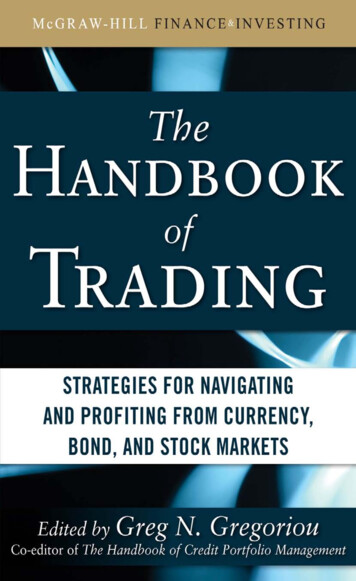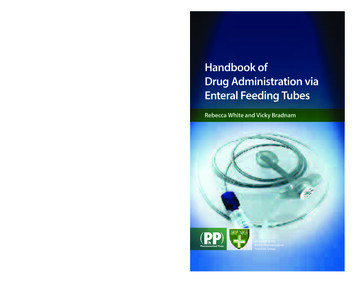
Transcription
Rebecca White and Vicky BradnamAn enteral feeding tube provides a means of maintaining nutritionalintake when there is limited access to the gastrointestinal tract. Theuse of enteral feeding tubes has increased for both short and longterm feeding in both primary and secondary care due to the increasein awareness of the importance of adequate nutritional intake.Handbook of Drug Administration via Enteral Feeding Tubes is apractical guide to the safe administration of medicines via enteralfeeding tubes. Ten chapters provide the background knowledge toinform clinical decisions, and the accompanying 344 monographscontain guidance on the safe administration of specific drugs andformulations.Contents include: types of enteral feeding tubes, tube flushing,restoring and maintaining patency, drug therapy review, medicationformulation choice, unlicensed medication use, health and safetyand interactions.Handbook of Drug Administration via Enteral Feeding Tubes is anessential guide for pharmacists, doctors, nurses, dieticians,and also for nursing homes and hospices.Rebecca White is Lead Pharmacist, Nutrition and Surgery,Oxford Radcliffe Hospitals NHS Trust, Oxford, UK.www.pharmpress.comon behalf of theBritish PharmaceuticalNutrition GroupAdminEntFINALFINAL.indd 1Handbook ofDrug Administration viaEnteral Feeding TubesRebecca White and Vicky BradnamWhite and BradnamVicky Bradnam is Chief Pharmacist, Bromley Hospitals NHS Trust,Kent, UK.Handbook of Drug Administration via Enteral Feeding TubesHandbook of Drug Administrationvia Enteral Feeding Tubeson behalf of theBritish PharmaceuticalNutrition Group2/11/06 09:20:13
01 1603PP FM.qxd26/10/067:56 pmPage iHandbook of Drug Administrationvia Enteral Feeding Tubes
01 1603PP FM.qxd26/10/067:56 pmPage ii
01 1603PP FM.qxd26/10/067:56 pmPage iiiHandbook of DrugAdministration viaEnteral Feeding TubesRebecca WhiteBSc (Hons) MSc MRPharmSLead Pharmacist; Nutrition and Surgery,Oxford Radcliffe Hospitals NHS Trust, Oxford, UKVicky BradnamBPharm (Hons) ClinDip MBA Open MRPharmSChief Pharmacist, Bromley Hospitals NHS Trust, Kent, UKOn behalf of the British Pharmaceutical Nutrition GroupLondon Chicago
01 1603PP FM.qxd26/10/067:56 pmPage ivPublished by the Pharmaceutical PressAn imprint of RPS Publishing1 Lambeth High Street, London SE1 7JN, UK100 South Atkinson Road, Suite 200, Grayslake, IL 60030-7820, USA Rebecca White and Vicky Bradnam 2007is a trade mark of RPS PublishingRPS Publishing is the publishing organisation of theRoyal Pharmaceutical Society of Great BritainFirst published 2007Typeset by MCS Publishing Services Ltd, Salisbury, WiltshirePrinted in Great Britain by Cambridge University Press, CambridgeISBN-10 0 85369 648 9ISBN-13 978 0 85369 648 3All rights reserved. No part of this publication may be reproduced,stored in a retrieval system, or transmitted in any form or by anymeans, without the prior written permission of the copyright holder.The publisher makes no representation, express or implied, withregard to the accuracy of the information contained in this book andcannot accept any legal responsibility or liability for any errors oromissions that may be made.A catalogue record for this book is available from the British Library
02 1603PP CON.qxd23/10/069:48 pmPage vContentsForewordxIndividual drug monographs:PrefacexiAbacavir58About the authorsxiiAcamprosate59List of ol62Notes on the use of this bookxixAceclofenac63Acenocoumarol lovir68Acitretin70Alendronic acid72Alfacalcidol74Allopurinol75Alverine citrate77Amantadine hydrochloride78Amiloride hydrochloride791. Introduction12. Types of enteral feeding tubes43. Flushing enteral feeding tubes94. Restoring and maintainingpatency of enteral feeding tubes145. Drug therapy review216. Choice of medication formulation237. The legal and professionalAmiodarone hydrochloride80Amitriptyline icin879. Syringes and ports48Amprenavir89Anastrazole9010. Defining interactions52Ascorbic acid91Aspirin93consequences of administeringdrugs via enteral feed tubes358. Health and safety and clinicalrisk managementAtenolol94Atorvastatin96Auranofin98
02 1603PP CON.qxdvi23/10/069:48 pmPage viHandbook of Drug Administration via Enteral Feeding hiazide104Clobazam163Betahistine105Clomipramine ne108Clonidine amol174Bisoprolol fumarate116Codeine phosphate176Bromocriptine ine182Cabergoline123Cyclophosphamide184Calcium folinate (Leucovorin)124Dantron (Danthron)185Deflazacort187Calcium resonium(Polystyrene sulphonate resins)125Desmopressin acetate188126Dexamethasone190Calcium salts with vitamin D128Diazepam192Candesartan cilexetil130Diclofenac sodium194Captopril131Dicycloverine (Dicyclomine)Calcium vedilol136Digoxin198Cefalexin (Cephalexin)137Dihydrocodeine tartrate200Cefixime139Diltiazem202Cefradine e sodium206Celecoxib144Domperidone208Celiprolol hydrochloride145Donepezil209Cetirizine hydrochloride146Dosulepin (Dothiepin) namine (Chlorpheniramine)hydrochloride196Doxepin hydrochloride214148Doxycycline215Chlorpromazine hydrochloride150Efavirenz217Chlortalidone (Chlorthalidone)151Enalapril prosartan mesilate221Cinnarizine155Ergometrine maleate222Ciprofloxacin156Erythromycin224maleate
02 1603PP CON.qxd23/10/069:48 pmPage viiContentsviiEscitalopram225Hydroxycarbamide (Hydroxyurea)283Esomeprazole226Hydroxyzine hydrochloride284Ethambutol228Hyoscine butylbromide285Ethinylestradiol229Hyoscine te232Imipramine 34Indometacin e237Inositol 239Iron ne hydrochloride241Isosorbide dinitrate300Finasteride242Isosorbide mononitrate301Flavoxate hydrochloride243Ispaghula ortisone acetate249Ketoprofen308Fluoxetine hydrochloride250Ketorolac trometamol309Flupentixol (Flupenthixol)252Labetalol xamine maleate257Lamotrigine316Folic urosemide (Frusemide)261Lercanidipine tamine limepiride270Levothyroxine sodium328Glipizide271Linezolid330Glyceryl mine hydrochloride334Granisetron dine337Haloperidol278Lorazepam338Hydralazine hydrochloride279Losartan hone hydrochloride282Magnesium preparations342(Methotrimeprazine)327
02 1603PP CON.qxdviii23/10/069:48 pmPage viiiHandbook of Drug Administration via Enteral Feeding TubesMebendazole344NorethisteroneMebeverine Olanzapine410Mefenamic acid348Olmesartan medoxomil411Megestrol acetate349Olsalazine sodium412Meloxicam350Omeprazole413Memantine iprenaline sulphate417Mesalazine354Orlistat418Metformin epam420Methyldopa359Oxprenolol hydrochloride421Methylprednisolone361Oxybutynin hydrochloride423Metoclopramide hydrochloride362Oxycodone oprolol tartrate365Pancreatic enzyme etine ne hydrochloride432Mirtazapine373Perindopril 76Phenobarbital llin438Moexipril hydrochloride378Phenytoin439Morphine ophenolate mofetil383Potassium444Nabumetone384Pravastatin sodium446Nadolol386Prednisolone447Naftidrofuryl 50Nebivolol390Procyclidine hydrochloride452Nefopam hydrochloride391Promethazine hydrochloride453Nelfinavir392Propranolol hydrochloride455Neomycin sulphate393Pyrazinamide457Nevirapine394Pyridoxine hydrochloride459Nicardipine pril461Nifedipine398Rabeprazole itidine antoin404Rifabutin467Nizatidine406Rifampicin469407
02 1603PP CON.qxd23/10/069:48 pmPage ixContentsixRiluzole470Tolbutamide512Risedronate sodium472Tolterodine 5Tramadol uvastatin478Tranexamic acid519Saquinavir479Trazodone hydrochloride520Selegiline hydrochloride480Trifluoperazine hydrochloride522Senna482Trihexyphenidyl imvastatin485Trimipramine527Sodium clodronate487Ursodeoxycholic acid528Sodium picosulfate489Valaciclovir530Sotalol hydrochloride490Valproate (Sodium e494Vancomycin hydrochloride535Sucralfate495Venlafaxine hydrochloride536Sulfasalazine496Verapamil hydrochloride537Sulpiride498Vigabatrin539Tamoxifen citrate499Vitamin E540Tamsulosin rin sodium543Temazepam503Zalcitabine545Tenofovir disoproxil504Zidovudine545Terbinafine505Zinc Timolol maleate510Index551Tizanidine hydrochloride511hydrochloride524525
03 1603PP FOR.qxd23/10/069:48 pmPage xForewordThe need for this text has been highlighted within the British Pharmaceutical NutritionGroup (BPNG) and the British Association of Parenteral and Enteral Nutrition (BAPEN)by healthcare professionals who are challenged on a daily basis by complex patientswhose need for medicines does not fit neatly into the categories used by the pharmaceutical industry as part of their process for licensing medicines. To provide the rightlevel of care for these patients, professionals have to make complex and rationaldecisions concerning medication, which may mean stepping outside the productlicence for the medication needed. As healthcare progresses and becomes more technical, such dilemmas become more commonplace. We hope this book will assisthealthcare professionals who have an input into either the patients’ medicines or theirenteral nutrition to understand the necessary decision process they must enter into andhow best to optimise their patient care, thereby ensuring the desired outcomes to meetthe patients’ medical and personal needs.The data in the individual drug monographs is based on available evidence suppliedby the drug companies, to whom we are very grateful for their support, and also onresearch undertaken by pharmacists.The production of this text has raised many questions concerning the data availablerelating to this method of medication administration; the BPNG will continue tosupport research in this growing area of practice.Thanks are due to all the healthcare professionals who have given their time andexpertise to ensure the practical applicability of this book. Thanks must also go toRebecca White who has led tirelessly on this project and undertaken much of theresearch to produce this comprehensive guide to drugs and enteral feeding tubes.Vicky BradnamChief PharmacistBromley Hospitals NHS Trust
04 1603PP PRE.qxd23/10/069:49 pmPage xiPrefaceThe initiative to prepare these guidelines was taken by the British PharmaceuticalNutrition Group (BPNG) with the support of the British Association of Enteral andParenteral Nutrition (BAPEN).This book reflects current practice and the information available at the time ofgoing to press. Although the authors have made every effort to ensure that theinformation contained in this reference is correct, no responsibility can be accepted forany errors.It is important to note that owing to the method of administration concerned, mostof the recommendations and suggestions in this reference fall outside of the terms ofthe product licence for the drugs concerned. It must be borne in mind that anyprescriber and practitioner administering a drug outside of the terms of its productlicence accepts liability for any adverse effects experienced by the patient.Readers outside the United Kingdom are reminded to take into account local andnational differences in clinical practice, legal requirements, and possible formulationdifferences.All enquiries should be addressed to:Rebecca WhiteBritish Pharmaceutical Nutrition GroupPO Box 5784DerbyDE22 32HUK
05 1603PP ATE.qxd23/10/069:50 pmPage xiiAbout the authorsThe British Pharmaceutical Nutrition Group, founded in 1988, is an organisation witha professional interest in nutrition support. The members of this group are pharmacists,technicians and scientists from the health service, academia and industry.The aims of the group are to promote the role of pharmaceutical expertise andexperience in the area of clinical nutrition and to ensure the safe and effectivepreparation and administration of parenteral nutrition through effective education andresearch initiatives, and to encourage debate into pharmaceutical aspects
Handbook of Drug Administration via Enteral Feeding Tubes is a practical guide to the safe administration of medicines via enteral feeding tubes. Ten chapters provide the background knowledge to inform clinical decisions, and the accompanying 344 monographs contain guidance on the safe administration of specifi c drugs and formulations. Contents include: types of enteral feeding tubes, tube .

